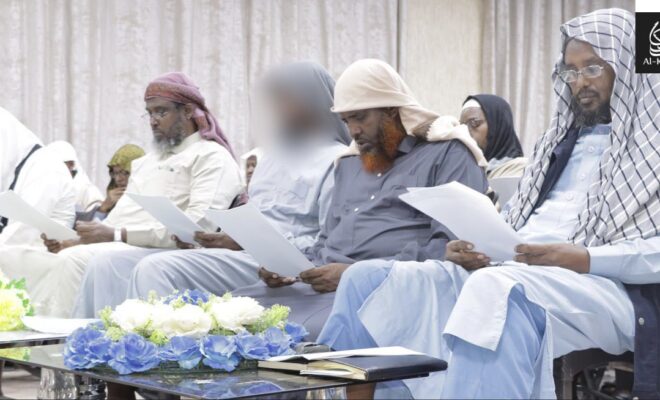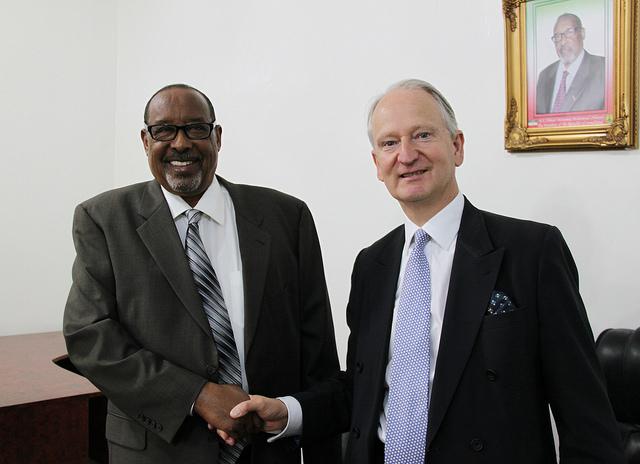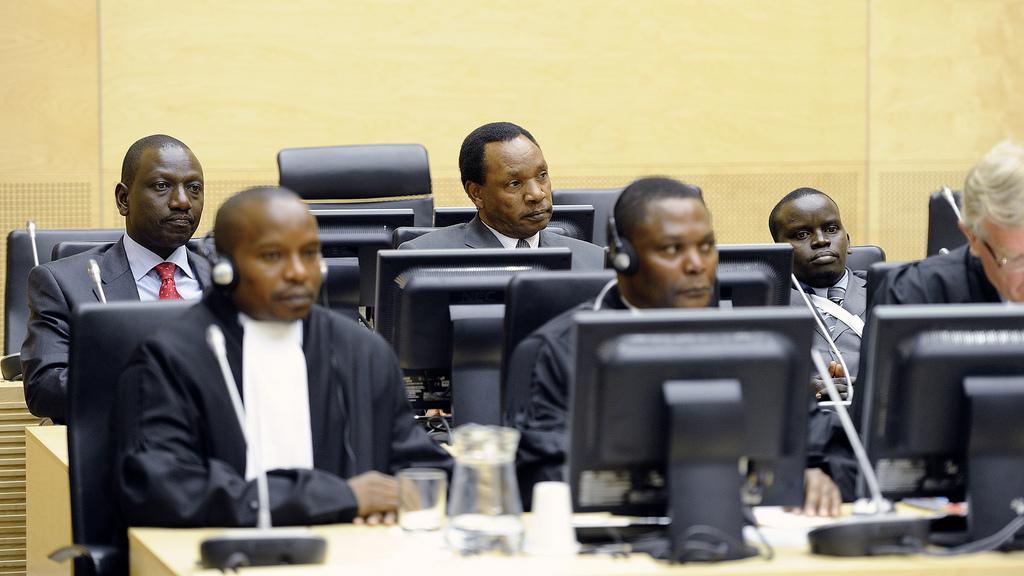
Debating Ideas aims to reflect the values and editorial ethos of the African Arguments book series, publishing engaged, often radical, scholarship, original and activist writing from within the African continent and beyond. It offers debates and engagements, contexts and controversies, and reviews and responses flowing from the African Arguments books.

Top al-Shabaab leaders in the front row, from left to right: Ali Dhere (Spokesperson), Abu Ubaidah (emir), Hassan Yaqub (former Galgudud Waali; current role not known but he reportedly does lot of outreach work for the group), and Sheikh Mohamed Aala-Suldan (former zakat chief, now reportedly senior adviser to the emir). 2nd Conference on Jihad in East Africa, May 2023. Source: @HarunMaruf
Somalia has been plagued by a persistent, escalating instability and political crisis for over three decades. The threat from al-Shabaab, a militant Islamic insurgent group, has created a state of perpetual political tensions and conflicts. After the new Federal Government of Somalia (FGS) came to power in May 2022, it put forward a directive that made fighting the group its top priority. Since then, al-Shabaab has intensified its indiscriminate attacks against civilians. There are several critical questions. Can the 7,000-12,000 fighters of al-Shabaab be defeated through ‘total war’ or al-Shabaab’s political Islam be accommodated? Is a peaceful Somalia possible through political engagement?
According to ACLED, last year was ‘the deadliest year in Somalia’ – with al-Shabaab killing at least 613 and injuring 948 civilians. The group was linked to ‘more than 2,400 political violence events’, with an increase of 19% in battle events and 41% in violence targeting civilians compared to 2021. For instance, Somaliland leaders implicated al-Shabaab in the recent Las Anod conflict but the group, in its press release, has rejected the claim as ‘baseless’ allegation. Al-Shabaab accounted for 37% of all Islamism-based group attacks in Africa in 2022.
In East Africa, al-Shabaab carried out attacks with the clear message that every African Union Mission in Somalia (AMISOM) troop-contributing country would ‘face attacks on [its] territory’. Based on various media and security sources, al-Shabaab was responsible for a suicide bombing and attacks that killed about 400 people in Uganda and Kenya over 2010–22. Recently, one of its biggest operations has been conducted in Ethiopia. Al-Shabaab clashed with Ethiopian soldiers in 2022 and remains active in the Ethiopia-Somalia border area. This incessant violence and its attacks across the region demonstrate the ongoing security threat posed by the group.
Al-Shabaab’s strength and warfare capabilities
In the face of the FGS and the African Union’s renewed offensive, al-Shabaab has proved to be resilient, able to endure coordinated attacks and evolve ‘from being primarily a military threat, to a more asymmetric and hybrid entity’. The USA considers the group ‘al Qaeda’s wealthiest and most kinetically active affiliate’. It generates around $100 million per year and is believed to directly finance al-Qaeda’s other worldwide operations. Its leader Ahmed Diriye, interviewed at the 2nd Conference on Jihad in East Africa, 8–15 May 2023, is a target under the USA’s $10 million Rewards for Justice bounty programme.
Domestic popular support for al-Shabaab has fluctuated. Initially, Ethiopia’s invasion in 2006 and the subsequent foreign intervention helped the group gain broader support. While the relationships among the group’s leaders from different clans and clan allegiances are inconsistent, the group is still able to make people internalise its values and thinking and to motivate young people to join. As elsewhere in the region, large pools of undereducated and underemployed youth provide fertile ground for political populism, which can be married to religion. As Ihsan Yilmaz notes, Islamist Populist discourses can be grounded in ‘conspiracies, anti-Western sentiments, Islamist victimhood narratives’. In Somalia joining Al-Shabaab can be seen as travelling ‘to the land of jihad’. However, expanding its ‘global jihad network’ and ‘its draconian style of governance’, including blocking aid deliveries during Somalia’s 2011 drought, triggered a drastic decline in al-Shabaab’s support locally. But this was turned around after al-Shabaab, having learnt its lesson, responded proactively during the 2017 drought and provided social and administrative services in areas that are not reached by the government and aid organisations.
The AU and US military intervention in Somalia
The African Union Transition Mission in Somalia (ATMIS), which reconfigured AMISOM effective from April 1, 2022, comprises around 20,000 troops and has been at the forefront of fighting al-Shabaab. ATMIS, supported by troops from Burundi, Djibouti, Ethiopia, Kenya and Uganda, is mandated to restore lasting peace, mainly through degrading al-Shabaab. Ambitiously, it aims to handover its duties to the Somali forces by December 2024.
ATMIS/AMISOM, however, has been facing shrinking funds and uncertainties, slowing down progress towards its exit strategy. Since 2007, the EU has contributed nearly €2.5 billion. The UN and the USA provide logistical, operational and training support. The USA, specifically under its Peacekeeping Operations Assistance (2002–22), supported the mission with approximately $3 billion. Yet, the AU has reported a nearly $90 million funding gap in 2023.
The USA, since the 1993 Black Hawk Down failed operation, has had a vague foreign and security policy on Somalia – largely avoiding direct intervention in the country. Anchored to its counterterrorism operations, Washington however sent troops and security advisors, while financing AU missions and Somali forces to the tune of several billion dollars.
Reversing its redeployment of the first regular US troops since 1994, following the deaths of several Americans stationed in Somalia, the Trump administration’s Pentagon had decided to pull out a group of some 700 security personnel on 15 January 2021. Controverting this, Biden’s administration sent troops back to Somalia in mid-2022. Currently, the State Department is funding the Danab special forces training base – supporting a commando brigade, with about 1,500 soldiers.
Through AFRICOM, US drone attacks increased by 30% in 2022 compared to 2021. Of the total 380 strikes conducted between March 2003 and November 2022, 74% were conducted under the Trump administration. Such airstrikes have killed many al-Shabaab operatives, though Washington has been criticised for the increased civilian casualties, with 78 people killed.
AU-US joint military support for the Somalian government has pushed al-Shabaab to withdraw from Mogadishu and engage in asymmetric warfare; however, attacks on civilians and military targets have not decreased – rather, they have increased dramatically. Notwithstanding this, the Somali National Army (SNA), with the support of local/clan militias, and in a reasonably well coordinated operation with US and Turkish air/drone strikes, ATMIS and other backing, has recently taken territory from al-Shabaab, including parts of Hirshabelle and Galmudug states. The second phase of the ‘total war’, aiming to fully utilise untapped resources and regional alliances, as discussed in the next section, plans to advance further south and control the Southwest and Juba-land states. While in the first phase the Somali government sought clan militia support (particularly from the Hawiye clan) in central Somalia, the government is not expected to be able to garner significant support from the clans of the southern regions. And still, the FGS continues to be criticised for lacking a clear strategy to bring to an end the conflict with al-Shabaab.
Regional actors’ alliances echoing the common narrative of ‘total war’
The political marketplace of Somalia is influenced by the competing interests of the regional actors who either sent troops or used their soft power for leverage in Somalia. The emerging alliances reflect the common narrative of militarily defeating al-Shabaab. Eritrea-Ethiopia-Somalia signed the 2018 Tripartite Agreement. Over the last three years, Eritrea has trained 5,000 young Somalis on its soil, boosting the army’s combat capacity in the war against al-Shabaab. Somalia has sent a further 3,000 soldiers to Eritrea, while Uganda, with assistance from the UAE, graduated 3,000 soldiers last March. An additional 6,000 soldiers are expected to be sent to Ethiopia and Egypt in 2023.
Advancing the ‘total war’ agenda, Mogadishu hosted the Somalia-Frontline States Summit in January 2023. The leaders of Somalia, Kenya, Ethiopia and Djibouti reaffirmed their commitment to joint anti-terrorism efforts. In an effort to consign al-Shabaab to history, these neighbouring countries have committed to ‘sending more than 30,000 troops’ to Somalia. Similarly, the presidents of Eritrea and Kenya issued a joint statement last February, bilaterally pledging to bring regional peace, including by defeating al-Shabaab.
The Gulf countries and Turkey’s financial, security and military support provide another layer of political influence in Somalia. The UAE signed an anti-terrorism cooperation agreement with Somalia last January, and in collaboration with Egypt is funding the training of soldiers in Somalia. Turkey is considered a reliable partner – with its training of the Gorgor Commandos. Nonetheless, will these politico-military alliances change the power balance in the Somalia war dynamics or enable the total defeat of al-Shabaab? That remains to be seen. The possibility of peaceful negotiations should weight these actors’ influence.
Steps forward for a lasting solution: are there any possibilities?
As the hasty withdrawal of US and allied forces from Afghanistan evidenced, militarisation cannot be the only option for bringing lasting solutions in Somalia; rather, all avenues for a peaceful settlement should be explored. While there have been a few attempts, little weight is given to a peaceful resolution, involving concessions and compromises. The negotiation process with al-Shabaab did not receive the same level of effort as the historic negotiation with the Taliban in Doha, Qatar in 2020. Within this context, we need to ask some basic questions. What does al-Shabaab want? The formation of an Islamic state? Or is their call primarily for the expulsion of foreign forces from Somalia? Can they be reconciliatory?
Despite his military campaign, President Mohamud admitted al-Shabaab ‘cannot be defeated militarily alone’, though he believes that the campaign is ‘a very important component for their defeat’. Experts suggest there is little evidence that the group will be ‘defeated militarily’. The search for a solution, rather, entails multifaceted and all-inclusive processes. Though striking a peace deal with al-Shabaab would be difficult, fresh thinking is required.
Recent trends reveal some elements that can open a way to negotiation with al-Shabaab. Despite its expansionist narrative, al-Shabaab has ‘abandoned its transnational goals to focus on local issues’ and this can create a ‘new opportunity for negotiation’. The role and influence of foreign fighters on al-Shabaab has been declining. The government has claimed that al-Shabaab requested to begin negotiations for the first time, though the group has denied this. As documented in USIP’s When Should We Talk to Terrorists?, the longer a terrorist group exists, the more likely it is to have successful negotiations. This suggests that dropping the government’s ‘do not negotiate with terrorists’ position is an indispensable step. Without ignoring regional and international geo-political interests, an effort to gain a deeper understanding of the pillars of Somalia’s domestic politics can inform and advance moves towards a peaceful settlement of Somalia’s problems.
In converging the diverging agendas of the parties to the war and their geo-political alliances, we must seek and extensively study areas of commonality between the FGS and al-Shabaab and explore ways to narrow their differences and deepen their relationship. This should include studies of how strict interpretations of Islamic law and political Islam can be adapted within Somalia’s context – beyond depoliticising religious politics. Islam is at the core of Somali identity and, looking beyond its short-term employ in mass mobilisation, ways can be devised to make it a means to strengthen national unity.
Understanding why al-Shabaab appeals to young Somalis or diaspora youth, or appears to be an answer to their aspirations or frustrations, is important. Offering alternatives can provide the needed impetus to a peace process. Thus, promoting decent employment, sensitisation and fighting systemic societal inequalities can serve as a cornerstone for a peacebuilding strategy. Somalia’s problems are deep, requiring measures that go beyond counterterrorism.
Despite the existence of inter-clan conflicts in Somalia, some level of coexistence and peace has been maintained through the Xeer — a traditional conflict resolution/legal system. In their localities, clan leaders have been able to fill the vacuum created by the lack of a central government. Religious and senior clan leaders could also facilitate informal backchannel discussions with al-Shabaab. Somali-led negotiations can retain legitimacy and build confidence and trust in the process. In the political landscape of Somalia, clannism and clan power politics, we must never forget, are central in the creation of alliances and in shifting powers in relation to al-Shabaab.
Once a cessation of hostilities has been maintained, it will be important to consider revoking the terrorist designation of al-Shabaab and granting amnesty to its members. Tailored social and financial incentives can have a positive impact on them. Rehabilitating Somalia requires socio-cultural healing, as well as substantial investment.
Somalia’s transition to peace and prosperity requires efforts that go far beyond a single and rebranded AU military mission. The USA should depart from its War on Terror policy, while the EU critically needs to restructure its funding policies to foster actions that will promote lasting peace. The global actors should converge their peace and security interests, and reconsider an approach based merely on degrading al-Shabaab’s capacity. Rather than seeking to defeat al-Shabaab through ‘total war’, these actors should demonstrate their readiness to silence the guns and promote localised political settlement in Somalia.






